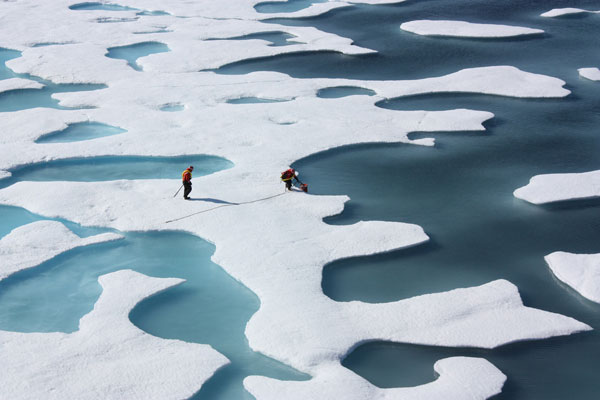America takes advantage of Arctic ice to track submarines
Sensing mounts on icebergs is how the US will apply to track submarines, surface ships and other Arctic hazards.
The Arctic ice is melting at the greatest speed in history and this speed tends to increase. That situation can make military and commercial activities more frequent in the Arctic - a harsh environment for sensors and navigation devices. However, scientists from the Department of Advanced Research Projects (DARPA) of the US Department of Defense have found a solution to monitor all activities in the Arctic. They will set up a sensor network in many places there, including tapes, Wired reported.

Icebergs on the Arctic Ocean surface are a threat to
The ships, but they will become America's "ears and eyes" in the future.
DARPA wants to attach electromagnetic and sound field sensors to floating ice sheets in the Arctic Ocean to track ships on water and submarines. The electromagnetic field sensors will be on the top of the iceberg, and the sound sensors are mounted on the underside. Since each iceberg can move up to 6 km per day (and this rate is increasing due to climate change), the sensors can collect data on a fairly wide area.
The working principle of the electromagnetic sensor is quite simple. When ships move in the Arctic Ocean, they must use radar to determine the location of dangerous icebergs. Sensors receive radar waves to determine the position of the ship. The existence of millions of icebergs in the Arctic also makes sound here disperse very quickly. So the sound sensors will pick up sounds from submarines to find out where they are.
Installation of sensors in the Arctic is part of DARPA's 'Assured Arctic Awareness' program. The agency has awarded two million dollars to the Science Applications International group to make the installation process.
The media said that the growing demand for energy and overlapping claims in the Arctic Ocean could lead to armed conflict between submarines of Russia, the US, Canada and Norway. Therefore, some analysts predict that DARPA's main purpose in establishing sensor systems in the Arctic Ocean is to monitor Russian submarines.
'Submarine detection is one of the obvious goals of sensor networks. However, they can also track floating ships and potential hazards like icebergs , 'said Andrew Coon, program manager for 'Assured Arctic Awareness' .
- Video: See the moment when American nuclear submarines float through the Arctic ice
- What weapons are stirring up the Arctic?
- Russia closed the giant submarine with wings twice as large as a jet
- The arctic has been 'hot'!
- Strange jellyfish in the Arctic Sea
- Detection of radiation leaking from Russian submarines at the bottom of the Arctic
- The most mysterious mystery submarine cases in the world
- 10 most expensive commercial submarines in the world
- Breaking into Russia's giant atomic submarine
- Russian non-nuclear submarines own attacks over 3,000km
- How will things change when submarines become underwater carriers?
- America revealed images of ice melting in the Arctic
 Is the magnetic North Pole shift dangerous to humanity?
Is the magnetic North Pole shift dangerous to humanity? Washington legalizes the recycling of human bodies into fertilizer
Washington legalizes the recycling of human bodies into fertilizer Lightning stone - the mysterious guest
Lightning stone - the mysterious guest Stunned by the mysterious sunset, strange appearance
Stunned by the mysterious sunset, strange appearance